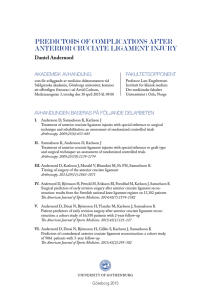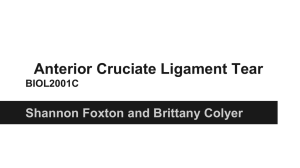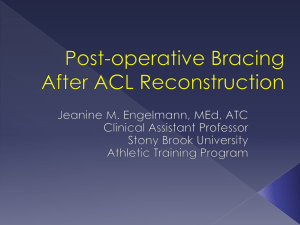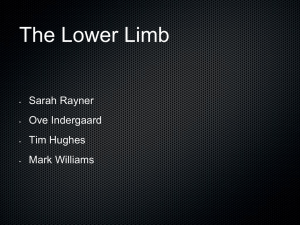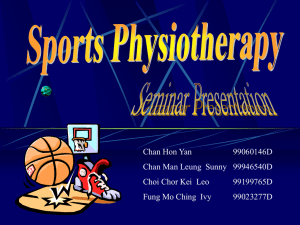Effects of the Menstrual Cycle on Lower-limb
advertisement
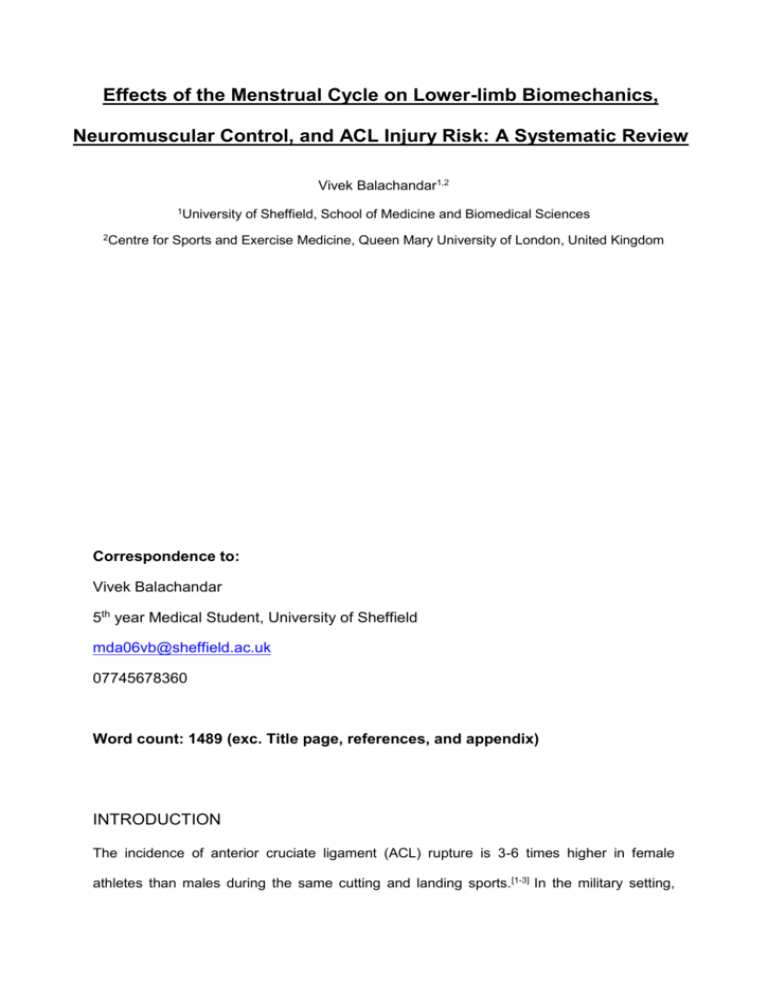
Effects of the Menstrual Cycle on Lower-limb Biomechanics, Neuromuscular Control, and ACL Injury Risk: A Systematic Review Vivek Balachandar1,2 1 University of Sheffield, School of Medicine and Biomedical Sciences 2Centre for Sports and Exercise Medicine, Queen Mary University of London, United Kingdom Correspondence to: Vivek Balachandar 5th year Medical Student, University of Sheffield mda06vb@sheffield.ac.uk 07745678360 Word count: 1489 (exc. Title page, references, and appendix) INTRODUCTION The incidence of anterior cruciate ligament (ACL) rupture is 3-6 times higher in female athletes than males during the same cutting and landing sports.[1-3] In the military setting, relative risks in females have been reported as high as 9.74 compared with men.[4] The evidence suggests that ACL injury has severe negative implications on mobility, athletic performance, academic performance, and personal finances.[5,6] Return to previous level of play is reported between 62%(7) and 67%(8) upto 5-years, with reduced knee function and fear of re-injury the most common reasons for failure.[7,8] Furthermore, return to previous level of play is significantly lower in females than males.[8] Long-term consequences are well investigated, and a recent systematic review reported upto 13% and 48% greater risk of knee osteoarthritis in patients with a previous isolated ACL rupture or combined ACL and meniscal injury.[9] The cause of ACL injury is multifactorial, with both extrinsic and intrinsic factors thought to contribute.[10,11] Extrinsic factors include physical and visual perturbations,[10-13] and shoesurface interactions.[10,11,14,15] Proposed intrinsic factors include female gender,[1-3,10,11] previous musculoskeletal injury (including prior ACL rupture),[10,11,16] and abnormal lower-limb anatomy,[10,11] biomechanics,[10,11,17] and neuromuscular control.[10,11,18] Hormonal mechanisms have also been proposed as a risk factor in female athletes. Hewett et al[19] published a highquality systematic review investigating the effects of the menstrual cycle on ACL injury risk until 2005. The review concluded that female athletes may be more predisposed to anterior cruciate ligament injuries during the pre-ovulatory phase of the menstrual cycle. However, only seven studies were reviewed,[20-26] and the effects of the menstrual cycle on lower-limb biomechanics and neuromuscular control were not evaluated. Considering the high number of recent publications, a systematic review evaluating the effects of the menstrual cycle on lower-limb biomechanics, neuromuscular control, and ACL injury risk is warranted. • METHODS 1.1 Search Strategy MEDLINE, CINAHL, SPORTSDiscus (SD), Web of Science (WoS), and Google Scholar databases were searched from inception until September 2011 (table 1). 1.2 Inclusion and Exclusion Criteria Studies evaluating the effects of the menstrual cycle on lower-limb kinematics, kinetics, and neuromuscular control during weight-bearing functional activities, and non-contact ACL injury risk in females (18-45) were included. Unpublished studies, case-reports, non-peer reviewed publications, studies not involving humans, reviews, letters, and opinion articles were excluded. Studies including participants with previous oral contraceptive pill (OCP) use were excluded unless non-OCP participant groups were separated. 1.3 Review Process and Data Extraction All retrieved studies were downloaded to Endnote version X4 (Thomson Reuters Philadelphia, PA). Results were cross-referenced and duplicated studies were deleted. Relevant titles were highlighted, with abstracts and full texts reviewed independently for inclusion (figure 1). Data was extracted from each paper to assist with interpretation of findings (appendix A) Keywords MEDLINE 11194 #1 Anterior AND cruciate AND ligament #2 ACL #3 Combine #1 OR #2 #4 Biomechanics OR biomechanical OR kinetic OR kinematic OR neuromuscular 7975 #5 Combine #3 OR #4 71009 #6 Menstrual OR menstruation Combine #3 AND #4 7373 13539 10665 518 Table 1: Search strategy Potentially relevant studies identified and screened for retrieval (n=518) Studies excluded (n=490) Studies included after reading titles (n=28) Studies excluded (n=11) Studies included after reading abstracts (n=17) Studies excluded (n=2) Studies included after reading full-texts (n=15) Figure 1: Search strategy outcomes at each stage 2. RESULTS Appendix-A summarises the main methodological criteria and results for the included studies. Six studies in this review investigated lower-limb biomechanics,[27-32] four neuromuscular control,[29,30,32,33] and ten ACL injury risk.[20-26,34,35] The studies were separated into four main outcome measure categories for further review: i) lower-limb kinematics, ii) lower-limb kinetics, iii) neuromuscular control, and iv) ACL injury risk. 3. DISCUSSION The aims of the review were to summarise the effects of the menstrual cycle on lower-limb kinematics, lower-limb kinetics, neuromuscular control, and ACL injury risk. Greater knee valgus and lower knee adduction moments, lower hip external rotation moments, and lower knee joint position sense in the follicular phase may be risk factors for ACL injury in females. Evidence from this review suggests that females are at significantly greater risk of noncontact ACL injury during the pre-ovulatory phase of the menstrual cycle, with greatest risk during the follicular phase.[21,22,24,36-38] Cyclic fluctuations of gonadal hormones have been reported as a possible cause of ACL injury. As a result, many studies have investigated changes in lower-limb biomechanics and neuromuscular control during the menstrual cycle, and a number of mechanisms have been proposed. • Possible Mechanisms Levels of oestrogen fluctuate throughout the menstrual cycle, with the greatest surges in the late follicular phase (days 8-14 in a 28-day cycle).[39,40] Previous studies have reported that tensile properties of ligaments are influenced by levels of oestrogen, and that oestrogen receptors are present within fibroblasts of human anterior cruciate ligaments. [41,42] A number of studies have focused on changes in passive structures during the menstrual cycle. Studies investigating changes in ACL laxity have reported an increase in knee joint laxity during the ovulatory and luteal phases compared with follicular phase.[28,31,33,34] One hypothesis suggests that reduced knee joint laxity or greater stiffness during the follicular phase may lead to increased risk of ACL injury in females.[19] This represents a possible mechanism of ACL injury, however, prospective research investigating menses and kneejoint laxity prior to injury is required to identify inconsistencies between study designs, and whether retrospective data is adequate. The effects of the menstrual cycle on neuromuscular control has been investigated as a possible mechanism behind ACL injury in females. Evidence from this review suggests no significant changes in gluteus medius onset timing[29] or hamstring and quadriceps strength[29,32] during functional movements between phases of the menstrual cycle. However, studies have also reported that oestrogen increases quadriceps contractile strength and slows relaxation during the ovulatory phase,[43] and decreases knee joint kinesthesia during the pre-menstrual phase.[35] One hypothesis suggests that fluctuations in serum oestrogen concentrations during the menstrual cycle affects muscle function and represent a mechanism of ACL injury in females.[43] A second hypothesis suggests the menstrual cycle has a significant influence on knee joint kinesthesia and ACL injury risk in females. [35] Considering the conflicting evidence, and the different variables measured, further highquality evidence is required to identify changes in neuromuscular control during the menstrual cycle and how this contributes to ACL injury risk in females. Evidence from this review suggests an increase in knee valgus, and decrease in knee adduction moments and hip external rotation moments during functional movements in the follicular phase of the menstrual cycle.[28,29] A combination of hip adduction and internal rotation, knee abduction, tibial external rotation, and ankle eversion has been described as a dynamic lower-extremity valgus.[19] One hypothesis suggests that increased dynamic valgus increases the risk of frontal plane valgus collapse and ACL injury in females. [16,44] A number of cadaveric, in vivo, and computer modeling studies have found that knee valgus can increase ACL strain high enough to cause rupture.[45-47] Increases in dynamic valgus between phases of the menstrual cycle may increase risk of ACL injury in females. While the evidence suggests a proximal risk factor for ACL injury in females, further investigation into distal mechanisms such as tibial internal/rotation and ankle eversion/inversion are required to identify the significance of these factors. • Limitations and future research A number of movements were used during biomechanical assessment: cutting, single-leg drop landing, two-leg drop landing, horizontal jump, vertical jump, and hop tests. The variability of movements between studies makes direct comparisons difficult to make. Furthermore, whilst these are reported as functional, the literature suggests that investigations of the ACL should focus on dynamic movements such as rapid deceleration and change of direction.[10] It is possible that negative findings from studies using movements such as two-leg drop landing, horizontal jump, and vertical jump may be a result of these less functional movements. Future studies should focus on high-risk movements that mimic ACL injuries and allow direct comparisons to be made. Anterior cruciate ligament injury has significant consequences in athletes at all levels. Interventions aimed at altering menstrual cycle pattern such as oral contraception are commonly used by athletes.[48] The evidence suggests that oral contraception may help to stabilise lower-limb biomechanics and neuromuscular control, and reduce ACL injury risk,[49,50] however no direct relationship has been established. Further high-quality, RCTs investigating the effects of oral contraception on lower-limb biomechanics, neuromuscular control, and ACL injury risk are warranted to understand effects of the menstrual cycle on knee joint stability in female athletes. • CONCLUSION The evidence suggests that females are at significantly greater risk of non-contact ACL injury during the pre-ovulatory phase of the menstrual cycle, with greatest risk during the follicular phase. [21,22,24,36-38] Geater dynamic lower-extremity valgus, reduced knee joint laxity, and reduced knee joint kinesthesia represent possible mechanisms behind ACL injury risk in the follicular phase. Further high-quality research is required to identify the effects of neuromuscular control on ACL injury risk in the menstrual cycle. Further high-quality, RCTs investigating high-risk movements that mimic ACL injuries, and the effects of oral contraception on lower-limb biomechanics, neuromuscular control, and ACL injury risk are warranted. REFERENCES • Arendt E, Dick R. Knee injury patterns among men and women in collegiate basketball and soccer: NCAA data and review of literature. Am J Sports Med. 1995;23:694-701. • Agel J, Arendt EA, Bershadsky B. Anterior cruciate ligament injury in national collegiate athletic association basketball and soccer: A 13-year review. Am J Sports Med. 2005;33:524–530. • Griffin LY, Agel J, Albohm MJ, et al. Noncontact anterior-cruciate ligament injuries: risk factors and prevention strategies. J Am Acad Orthop Surg. 2000;8:141-150. • Gwinn DE, Wilckens JH, McDevitt ER, et al. The relative incidence of anterior cruciate ligament injury in men and women at the United States Naval Academy. Am J Sports Med. 2000;28(1):98-102. • Freedman KB, Glasgow MT, Glasgow SG, et al. Anterior cruciatate ligament injury and reconstruction among university students. Clin Orthop Relat Res. 1998;356:208-212. • Ruiz AL, Kelly M, Nutton RW. Arthroscopic ACL reconstruction: a 5-9 year follow-up. Knee. 2002;9:197-200. • Lee DYH, Karim SA, Chang HC. Return to Sports After Anterior Cruciate Ligament Reconstruction – A Review of Patients with Minimum 5-year Follow-up. Ann Acad Med Singapore 2008;37:273-8 • Ardern CL, Webster KE, Taylor NF, et al. Return to the Preinjury Level of Competitive Sport After Anterior Cruciate Ligament Reconstruction Surgery : Two-thirds of Patients Have Not Returned by 12 Months After Surgery. Am J Sports Med 2011 39: 538 • Oiestad BE, Engebretsen L, Storheim K, et al. Knee osteoarthritis after anterior cruciate ligament injury: a systematic review. Am J Sports Med. 2009;37:1434–1443 • Hewett TE, Myer GD, Ford KR. Anterior Cruciate Ligament Injuries in Female Athletes : Part 1, Mechanisms and Risk Factors.. Am J Sports Med 2006 34: 299 • Alentorn GE, Myer GD, Silvers HJ, et al Prevention of non-contact anterior cruciate ligament injuries in soccer players. Part 1: Mechanisms of injury and underlying risk factors. Knee Surg Sports Traumatol Arthrosc. 2009 Jul;17(7):705-29. • McLean SG, Lipfert SW, van den Bogert AJ. Effect of gender and defensive opponent on the biomechanics of sidestep cutting. Med Sci Sports Exerc. 2004;36:1008-1016. • Olsen OE, Myklebust G, Engebretsen L, et al. Injury mechanisms for anterior cruciate ligament injuries in team handball: a systematic video analysis. Am J Sports Med. 2004;32:1002-1012. • Orchard JW, Powell JW. Risk of knee and ankle sprains under various weather conditions in American football. Med Sci Sports Exerc. 2003; 35:1118-1123. • Scranton PE, Whitesel JP, Powell JW, et al. A review of selected noncontact anterior cruciate ligament injuries in the National Football League. Foot Ankle Int. 1997;18:772776. • Hewett TE, Myer GD, Ford KR, et al. Biomechanical measures of neuromuscular control and valgus loading of the knee predict anterior cruciate ligament injury risk in female athletes: a prospective study. Am J Sports Med. 2005;33:492-501. • Boden BP, Sheehan FT, Torg JS, et al. Noncontact anterior cruciate ligament injuries: mechanisms and risk factors. J Am Acad Orthop Surg. 2010 Sep;18(9):520-7. • Hewett TE. Neuromuscular and hormonal factors associated with knee injuries in female athletes: strategies for intervention. Sports Med. 2000;29:313-327. • Hewett TE, Zazulak BE, Myer GD. Effects of the Menstrual Cycle on Anterior Cruciate Ligament Injury Risk : A Systematic Review. Am J Sports Med 2007 35: 659 • Arendt EA, Agel J, Dick R. Anterior cruciate ligament injury patterns among collegiate men and women. J Athl Train. 1999;34:86-92. • Arendt EA, Bershadsky B, Agel J. Periodicity of noncontact anterior cruciate ligament injuries during the menstrual cycle. J Gend Specif Med. 2002;5:19-26. • Myklebust G, Engebretsen L, Braekken IH, et al. Prevention of anterior cruciate ligament injuries in female team handball players: a prospective intervention study over three seasons. Clin J Sport Med. 2003;13:71-78. • Myklebust G, Maehlum S, Holm I, et al. A prospective cohort study of anterior cruciate ligament injuries in elite Norwegian team handball. Scand J Med Sci Sports. 1998;8:149153. • Slauterbeck JR, Fuzie SF, Smith MP, et al. The menstrual cycle, sex hormones, and anterior cruciate ligament injury. J Athl Train. 2002;37: 275-278. • Wojtys EM, Huston LJ, Boynton MD, et al. The effect of the menstrual cycle on anterior cruciate ligament injuries in women as determined by hormone levels. Am J Sports Med. 2002;30: 182-188. • Wojtys EM, Huston LJ, Lindenfeld TN, et al. Association between the menstrual cycle and anterior cruciate ligament injuries in female athletes. Am J Sports Med. 1998;26:614-619. • Chaudhari AMW, Lindenfeld TN, Andriacchi TP. Knee and Hip Loading Patterns at Different Phases in the Menstrual Cycle: Implications for the Gender Difference in Anterior Cruciate Ligament Injury Rates. Am J Sports Med 2007;35:793 • Park SK, Stefanyshyn DJ, Ramage B. Alterations in Knee Joint Laxity During the Menstrual Cycle in Healthy Women Leads to Increases in Joint Loads During Selected Athletic Movements. Am J Sports Med 2009;37:1169 • Cesar BM, Pereira VS, Santiago PRP. Variations in dynamic knee valgus and gluteus medius onset timing in non-athletic females related to hormonal changes during the menstrual cycle. The Knee. 2011;18(4):224-230 • Abt JP, Sell TC, Laudner KG, et al. Neuromuscular and biomechanical characteristics do not vary across the menstrual cycle. Knee Surg Sports Traumatol Arthrosc. 2007;15(7):901-7 • Shultz SJ, Schmitz RJ, Beynnon BD. Variations in varus/valgus and internal/external rotational knee laxity and stiffness across the menstrual cycle. J Orthop Res. 2011;29(3):318-25. • Hertel J, Williams NI, Olmsted-Kramer LC, et al. Neuromuscular performance and knee laxity do not change across the menstrual cycle in female athletes. Knee Surg Sports Traumatol Arthrosc. 2006;14(9):817-22. • Shultz SJ, Schmitz RJ, Nguyen AD, et al. Knee joint laxity and its cyclic variation influence tibiofemoral motion during weight acceptance. Med Sci Sports Exerc. 2011 Feb;43(2):287-95. • Heitz NA, Eisenman PA, Beck CL, et al. Hormonal Changes Throughout the Menstrual Cycle and Increased Anterior Cruciate Ligament Laxity in Females. J Athl Train. 1999; 34(2): 144–149. • Fridén C, Hirschberg AL, Saartok T, Renström P. Knee joint kinaesthesia and neuromuscular coordination during three phases of the menstrual cycle in moderately active women. Knee Surg Sports Traumatol Arthrosc. 2006;14(4):383-9. • Beynnon BD, Robert J. Johnson, Stuart Braun The Relationship Between Menstrual Cycle Phase and Anterior Cruciate Ligament Injury : A Case-Control Study of Recreational Alpine Skiers. Am J Sports Med 2006;34:757 • Ruedl G, Ploner P, Linortner I. Are oral contraceptive use and menstrual cycle phase related to anterior cruciate ligament injury risk in female recreational skiers? 2009;17(9):1065-1069 • Ruedl G, Ploner P, Linortner I. Interaction of potential intrinsic and extrinsic risk factors in ACL injured recreational female skiers. Int J Sports Med. 2011 Aug;32(8):618-22 • Stricker R, Eberhart R, Chevailler MC, et al. Establishment of detailed reference values for luteinizing hormone, follicle stimulating hormone, estradiol, and progesterone during different phases of the menstrual cycle on the Abbott ARCHITECT analyzer. Clin Chem Lab Med. 2006;44(7):883-7. • Pauerstein CJ, Eddy CA, Croxatto HD, et al. Temporal relationships of estrogen, progesterone, and luteinizing hormone levels to ovulation in women and infrahuman primates. Am J Obstet Gynecol. 1978;15;130(8):876-86. • Booth FW, Tipton CM. Ligamentous strength measurements in prepubescent and pubescent rats. Growth. 1970;34:177-185. • Liu SH, Al-Shaikh RA, Panossian V, et al. Primary immunolocalization of Estrogen and progesterone target cell in the human anterior cruciate ligament. J Orthop Res. 1996;14:526-533. • Sarwar R, Beltran NB, Rutherford OM:. Changes in muscle strength, relaxation rate and fatiguability during the human menstrual cycle. J Physiol. 1996;493:267-272. • Quatman CE, Hewett TE. The anterior cruciate ligament injury controversy: is ‘‘valgus collapse’’ a sex-specific mechanism? Br J Sports Med. 2009;43:328–335 • Fukuda Y, Woo SL, Loh JC, et al. A quantitative analysis of valgus torque on the ACL: a human cadaveric study. J Orthop Res. 2003;21:1107-1112. • Lloyd DG, Buchanan TS. Strategies of muscular support of varus and valgus isometric loads at the human knee. J Biomech. 2001;34:1257-1267. • Markolf KL, Burchfield DM, Shapiro MM, Shepard et al. Combined knee loading states that generate high anterior cruciate ligament forces. J Orthop Res. 1995;13:930-935. • Agel J, Bershadsky B, Arendt E. Hormonal therapy: ACL and ankle injury. Med Sci Sports Exerc. 2006;38:7-12. • Moller-Nielson J, Hammar M. Sports injuries and oral contraceptive use. Is there a relationship? Sports Med. 1991;12:152-160. • Moller-Nielsen J, Hammar M. Women’s soccer injuries in relation to the menstrual cycle and oral contraceptive use. Med Sci Sports Exerc. 1989;21:126-129. Appendix A: Summary of studies included in systematic review Participant details Protocol Results Author/year 45 females athletes with ACL injury and 45 healthy females Groups matched for age, height, weight Serum sample and selfreported menstrual history data immediately after injury. Both serum concentrations of progesterone and menstrual history were used to group subjects Serum concentrations of progesterone revealed that alpine skiers in the preovulatory phase of the menstrual cycle were significantly more likely to tear their ACL than skiers in the postovulatory phase Analysis of menstrual history found similar results, but the difference was not statistically significant Cesar MG (2011) 23 female non-athletes Single leg drop landing maneuver while 3-D knee kinematics and gluteus medius muscle onset timing were assessed throughout three distinct phases of the menstrual cycle (confirmed by blood hormone analysis) Knee valgus angles were significantly less in the luteal phase compared to both follicular phases, while differences were not observed for gluteus medius onset timing. Ruedl G (2011) 93 female athletes with ACL injury and 93 healthy females Self-reported questionnaire relating to intrinsic risk and extrinsic risk factors Preovulatory phase of menstrual cycle (odds ratio, 2.59) was a independent ACL injury risk factor for female skiers Cyclic variations in genu recurvatum (GR), general joint laxity (GJL), varus-valgus (VV), and internal-external (IER) rotational laxities and stiffnesses were examined Cyclic increases in AKL (9.5%), GR (37.5%), and GJL (13.6%) were observed Cyclic increases in VV and IER laxity were negligible. Females had lower VV stiffness at T2 vs T1, but no difference across time points for IER stiffness. Across both time points, females had consistently greater VV and IER laxity and less VV and IER incremental stiffness Beynnon BD (2011) Shultz SJ (2011a) 64 healthy females No significant differences in knee joint mechanics. An increase in KJL was associated with higher knee joint loads during movement. A 1.3-mm increase in KJL resulted in an increase of approximately 30% in adduction impulse in a cutting maneuver, an increase of approximately 20% in knee adduction moment, and a 20% to 45% increase in external rotation loads during a jumping and stopping task Analysis revealed that recreational skiers in the preovulatory phase were significantly more likely to sustain ACL injury than skiers in postovulatory phase 72% of subjects had premenstrual symptoms, 83% had menstrual symptoms. Significant association between the phase of the menstrual cycle and ACL injuries. There were more injuries in the ovulatory phase than expected No significant difference between phases of the menstrual cycle for: i) fine motor coordination, ii) postural stability, iii) hamstring - quadriceps strength ratio at 60 degrees or 180 degrees, iv) knee flexion excursion, v) knee valgus excursion, vi) peak proximal tibial anterior shear force, vii) flexion moment at peak proximal tibial anterior shear force, vii) valgus moment at peak proximal tibial anterior shear force Park SK (2009) 26 female athletes Knee joint biomechanics were measured. Each subject was designated with low, medium, or high knee joint laxity. Knee joint mechanics were compared between low, medium, and high laxity Ruedl G (2009) 93 female athletes with ACL injury Menstrual history, athletic activity, and injury history were collected from the athletes Adachi N (2008) 18 female athletes with ACL injury Menstrual history, athletic activity, and injury history were collected from the athletes Abt JP (2007) 10 healthy females Mean age21.4 Mean height1.67cm Mean mass59.9kg Single-leg postural stability, fine motor coordination, knee strength, knee biomechanics, and serum estradiol and progesterone were assessed at the menses, post-ovulatory, and mid-luteal phases 12 female athletes Horizontal and vertical jump, and drop from a 30-cm box on the left leg. Lower limb kinematics and peak externally applied moments were calculated Women were tested for each phase of the menstrual cycle as determined from serum analysis No significant differences in moments or knee angle were observed between phases in female group 32 healthy female athletes Knee joint kinaesthesia and neuromuscular coordination was measured with the square hop test in the menstrual phase, ovulation phase and premenstrual phase determined by hormone analyses in three consecutive menstrual cycles. Impaired knee joint kinaesthesia was detected in the premenstrual phase and the performance of square hop test was significantly improved in the ovulation phase compared to the other two phases Hertel J (2006) 14 healthy female athletes Measures of knee neuromuscular performance and laxity once during the mid-follicular, ovulatory, and mid-luteal stages of menstrual cycle. Arendt EA (2002) 58 female athletes with ACL injury Menstrual history, athletic activity, and injury history were collected from the athletes 69 female athletes with ACL injury Mechanism of injury, menstrual cycle details, use of oral contraceptives, and history of previous injury were recorded. Urine samples validated menstrual cycle phase at the time of the ACL tear. Chaudhari AMW (2007) Friden C (2006) Wojtys EM (2002) No significant differences in the measures of strength, joint position sense, postural control, or laxity across the three testing sessions. No significant correlations were found between changes in E3G or PdG levels and changes in the performance and laxity measures between sessions A significant 28-day periodicity of injuries was present in the entire population as well as in the two subgroups. High- and low-risk time intervals were associated primarily with follicular and luteal phases Results from the hormone assays indicate that the women had a significantly greater than expected percentage of ACL injuries during midcycle (ovulatory phase) and a less than expected percentage of those injuries during the luteal phase of the menstrual cycle. Myklebust G (1998) Wojtys EM (1998) 23 female athletes Menstrual history, athletic activity, and injury history were collected from the athletes Five of the injuries occurred in the menstrual phase, 2 in the follicular phase, 1 in the early luteal phase and 9 in the late luteal phase 28 female athletes with ACL injury Mechanism of injury, menstrual cycle details, use of oral contraceptives, and history of previous injury were recorded. Observed and expected frequencies of ACL injury based on 3 different phases of the menstrual cycle A significant statistical association was found between the stage of the menstrual cycle and the likelihood for an ACL injury. There were more injuries than expected in the ovulatory phase of the cycle. In contrast, significantly fewer injuries occurred in the follicular phase. ACL – anterior cruciate ligament, KJL – knee joint laxity

